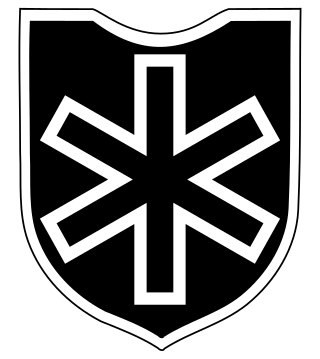
The Waffen-SS was the combat branch of the Nazi Party's paramilitary Schutzstaffel (SS) organisation. Its formations included men from Nazi Germany, along with volunteers and conscripts from both occupied and unoccupied lands. It was disbanded in May 1945.

The 6th SS Mountain Division Nord was a World War II mountain infantry division of the Waffen-SS, the military wing of the German Nazi Party, primarily consisting of ethnic Germans along with some Norwegian and Swiss volunteers. It was the only Waffen-SS division to operate in the Arctic Circle.

The SS Division Hitlerjugend or 12th SS Panzer Division "Hitlerjugend" was a German armoured division of the Waffen-SS during World War II. The majority of its junior enlisted men were drawn from members of the Hitler Youth, while the senior NCOs and officers were from other Waffen-SS divisions.

A Panzer division was one of the armored (tank) divisions in the army of Nazi Germany during World War II. Panzer divisions were the key element of German success in the blitzkrieg operations of the early years of World War II. Later the Waffen-SS formed its own panzer divisions, and the Luftwaffe fielded an elite panzer division: the Hermann Göring Division.
The Fallschirm-Panzer-Division 1. Hermann Göring was a German Luftwaffe armoured division. The HG saw action in France, North Africa, Sicily, Italy and on the Eastern Front during World War II. The division began as a battalion-sized police unit in 1933. Over time it grew into a regiment, brigade, division, and finally was combined with the Parachute-Panzergrenadier Division 2 Hermann Göring on 1 May 1944 to form a Panzer corps under the name Reichsmarschall. It surrendered to the Soviet Army near Dresden on 8 May 1945.

The 11th SS Volunteer Panzergrenadier Division Nordland was a Waffen-SS division primarily raised with Germans and ethnic Germans from Romania, but also foreign volunteers from Northern and Western Europe. It saw action, as part of Army Group North, in the Independent State of Croatia and on the Eastern Front during World War II.

The 12th Panzer Division was an armoured division in the German Army, established in 1940.

The 17th SS Panzergrenadier Division "Götz von Berlichingen" was a German Waffen-SS division that saw action on the Western Front during World War II.

The 20th Waffen Grenadier Division of the SS was a foreign infantry division of the Waffen-SS that served alongside but was never formally part of the Wehrmacht during World War II. According to some sources, the division was under Reichsführer-SS Heinrich Himmler's overall command but was not an integral part of the Schutzstaffel (SS). It was officially activated on 24 January 1944, and many of its soldiers had been members of the Estonian Legion and/or the 3rd Estonian SS Volunteer Brigade, which had been fighting as part of German forces since August 1942 and October 1943 respectively. Both of the preceding formations drew their personnel from German-occupied Estonia. Shortly after its official activation, widespread conscription within Estonia was announced by the German occupying authorities. The division was formed in Estonia around a cadre comprising the 3rd Estonian SS Volunteer Brigade, and was initially known as the 20th Estonian SS Volunteer Division.
The IX Waffen Mountain Corps of the SS (Croatian) (German: IX. Waffen-Gebirgskorps der SS (Kroatisches)), later simply IX SS Mountain Corps, was a Waffen-SS corps during World War II. Originally set up to control Croatian and Albanian SS divisions, it also commanded a variety of other German and Hungarian units of the Waffen-SS. It saw action on the Eastern Front between July 1944 and January 1945 when it was virtually destroyed during the Siege of Budapest.
The German 273rd Reserve Panzer Division was a reserve army division. After the Battle of Kursk the German 273rd Reserve Panzer Division was used for augmenting of 11th Panzer Division, whereas their remaining forces were shifted to the Italian front.
The 2nd Marine Division was a military formation of the German Navy (Kriegsmarine) under control of the German Army (Heer) during the later part of the Second World War.
The 19th Panzer Division was an armoured division in the German Army, the Wehrmacht, during World War II. It was created from the 19th Infantry Division.

The 30th Waffen Grenadier Division of the SS(1st Belarusian), originally called the 30th Waffen Grenadier Division of the SS , was a short-lived German Waffen-SS infantry division formed largely from Belarusian, Russian, Polish, and Ukrainian personnel of the Schutzmannschaft-Brigade Siegling in August 1944 at Warsaw in the General Government.

The 31st SS Volunteer Grenadier Division was a German infantry division of the Waffen-SS during the Second World War, commanded by SS-Brigadeführer, Gustav Lombard. The division was formed of German, Hungarian, Serbian and other Volksdeutsche, mostly from the Batschka region as well as the personnel and equipment from the 23rd Waffen Mountain Division SS 'Kama'. By 26 October 1944, Army Group South deployed the division to the frontlines to assist in securing the Danube, despite its complete lack of heavy weapons, inadequate training and weaponry. During the division’s stay in Lower Styria, an order from 16 January 1945 reorganised the division from a Type 1944 division into a Type 1945 division. A month later on 17 February 1945, orders were given for the immediate transfer of the division to Silesia in the Görlitz area in preparation for an upcoming offensive operation. Portions of the division were still under the 17th Army's command in the Hirschberg region, incorporated into their order of battle as army reservists.
II Army Corps was a corps in the German Army during World War II.
The Panzer Division Jüterbog was an armoured division of the Wehrmacht during World War II. Created on 20 February 1945, it was active for a short period of time.
The 49th Infantry Division was a military formation of the German Heer (Army) which served during the later years of the Second World War.










